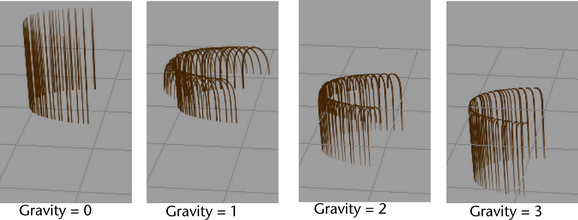These options appear as a subset of the section in the Paint Effects Brush Settings window, and the Attribute Editor for any brush node.
You can apply forces to the tubes at each step in the growth cycle. These small, cumulative changes affect the shape of the whole tube in a more systemic way, to produce different kinds of effects. You can apply spiral forces, gravity, wind, turbulence, and a repelling force that keeps tubes from passing through the ground. Because of the cumulative nature of growth, forces tend to have a greater effect at the tips of tubes than they do at the roots.
Certain forces, such as Path Attract and Path Follow, do not apply to leaves or flowers.
- Path Follow
-
Defines the magnitude of the force that attempts to make tubes grow in the same direction as their corresponding points on the stroke path. If the value is 0, no force is applied to the tubes. As the value increases, the tubes follow the path more closely. A positive value follows the stroke path (like combing the tubes in the direction of the stroke path) while a negative value follows the reverse stroke path (like combing the tubes against the direction of the stroke path).

- Path Attract
-
Defines the magnitude of the force that attracts tubes to the stroke path at each step of the growth simulation. If the value is 0, no force is applied to the tubes. As the value increases, the tubes converge onto the path. A positive value attracts tubes while a negative value repels them.

- Curve Follow
-
You can make tubes follow control curves that are associated with strokes. For details, see Modify tube behavior using control curves. The CurveFollow setting defines the magnitude of the force that tries to make tubes grow in the same direction as the associated control curves. A positive value attracts tubes while a negative value repels them.

- Curve Attract
-
You can make tubes attract to control curves that are associated with strokes. For details, see Modify tube behavior using control curves. The CurveAttract setting defines the magnitude of the force that attracts tubes to the associated control curves. A positive value attracts tubes, while a negative value repels them.

- Curve Max Dist
-
This setting has an effect only if Curve Attract or Curve Follow is on. It defines the maximum distance (in world units) from which a curve can exert a force on a tube. If Curve Max Dist is set to 0, there is no maximum.
- Surface Attract
-
Specifies the strength of an attractive force between the stroke and object surface. Surface Attract uses the closest point on surface to calculate which areas of the stroke and surface attract each other. Higher values increase the force of attraction, while negative values create a repulsive force.
Use Surface Attract for effects that require strokes to closely follow the contours of a painted surface, such as vines clinging to a wall. Turn on Surface Collide (see below) to resolve interpenetrating strokes and geometry.
- Max Attract Distance
-
Specifies the maximum distance from an object surface that Surface Attract has an effect. Higher values increase the attraction distance from the object surface. Negative Max Attract Distance values attract all points to the surface regardless of distance.
- Random
-
Defines the magnitude of a force with a random direction and intensity, applied in the local space of each tube. If the value is 0, no force is applied. As the value increases, the force increases. This value is useful for making trees and bushes appear gnarly.

- Uniform Force
-
Defines the magnitude of a basic directional force to apply to tubes. the x, y, and z world space coordinates. If a value is 0, no force is applied from that direction.

- Gravity
-
Defines the magnitude of a downward force (relative to the up axis). If the value is 0, no gravity is applied.

- Surface Collide
-
When on, tubes collide with the surface of the painted object. Use Surface Collide to resolve interpenetrations between the strokes and geometry when using Surface Attract.
- Collide Method
-
Specifies whether the stroke collides with the Outside, Inside, or Both Sides of the object surface.
- Deflection
-
Turn on Deflection to apply a force that stops tubes from passing through the surface or plane they are growing from (for example, when gravity pulls branches down). The force pushes upwards and is stronger closer to the surface or plane.
Note: Deflection uses an approximation of the surface to do the deflection (a plane), so deflection will work best for short tubes or relatively flat surfaces. To deflect longer tubes, use control curves with negative Curve Attract settings (see above).
- Deflection Min, Deflection Max
-
These settings are available only if Deflection is turned on. They define the range over which the deflection force is applied. Deflection Min is the closest distance (in world units) that the tube can get to the ground before the force becomes effectively infinite. Deflection Max is the distance from the ground where approaching tubes are first influenced by deflection.
- Momentum
-
Defines the magnitude of the force that slows down growth over the course of the growth simulation.
- Length Flex
-
Defines how much tube segments can stretch in response to forces. If the value is 0, no stretching occurs. If the value is 1, tubes stretch just as far as required to match the force.
